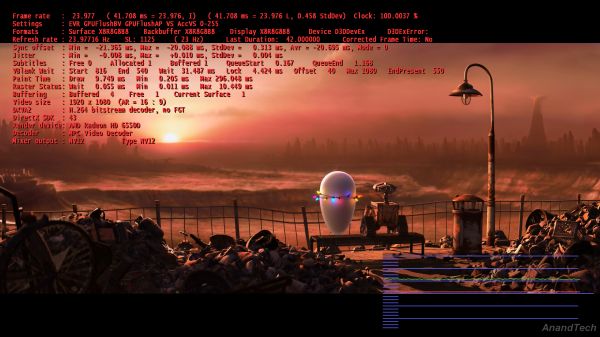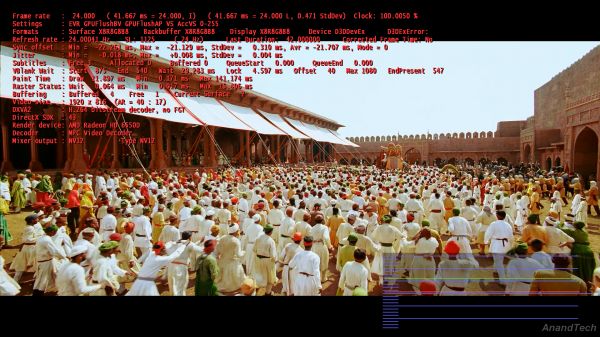AMD A8-3850 : An HTPC Perspective
by Ganesh T S on June 30, 2011 6:20 AM ESTOne of the main reasons for HTPC purists to override the Intel integrated GPUs was the lack of a proper 23.976 Hz refresh rate. AMD GPUs have a history of consistently supporting 23.976 and 24 Hz refresh rates. With the AMD 6550D, setting up these refresh rates was quite easy.
We have seen that Intel is able to achieve 23.976 Hz refresh of sorts by disabling UAC on Windows 7 systems. There is currently an Intel driver in the works which removes this restriction (and I have my hands on it! Expect to see how it performs when I review ASRock's CoreHT 252B in the coming days).
Back to the Lynx system, setting a 23 Hz refresh rate gets us the same sort of accuracy as was obtained with other AMD GPUs. Playback frame rate locks to 23.977 fps and the refresh rate oscillates on either side of 23.977 Hz. Instead of a repeated frame every 42 seconds, we get one every 1000 seconds, long enough for most people not to notice.
24 Hz refresh rate support is equally good.
We would like AMD to provide custom resolution and refresh rate support similar to what NVIDIA does. This would enable end users to tweak the pixel clock and related settings to appropriately match their setup.












104 Comments
View All Comments
ckryan - Thursday, June 30, 2011 - link
There's lots of good stuff to do with a GPU that doesn't involve games; unfortunately, it seems like that is the only thing AMD had in mind for the Llano GPU. It's unfortunate, since running a discrete GPU with Llano in its desktop form just seems to make Llano pointless. In a laptop you at least get decent game performance at low screen resolutions.My enthusiasm for the future of Llano isn't diminished, but strangely, it seems that Llano makes a cheap Phenom II + dGPU seem like a much better idea than it was yesterday.
Still, with some Bulldozer cores, improved GPU section, and some better drivers will go a long way to making Llano mainstream vs. a super-niche product for the desktop.
duploxxx - Thursday, June 30, 2011 - link
a super niche product for the desktop..... did you ever went to any large electronic shop? it's full of these kind of designs that you brand "niche". Check few OEM very soon they will all bulk this kind of Liano setups.... just like Brazos was a success this will also and already a major reason why intel introduces the 2105 just at release of Liano.... but the HD3000 over HD2000 remains crap.L. - Thursday, June 30, 2011 - link
You don't get it, the guy above is right !!!It's a super-niche product, for the biggest niche there is in the whole consumer market, normal people.
Gee AMD ... bad idea really ;)
Ananke - Thursday, June 30, 2011 - link
:) Llano is exactly what the mass-consumer grade computer market uses and needs. That's 99.5% of the total market. The other negligible 0.5% is enthusiast market, where most of the AnandTech readers belong. Intel is still king there.therealnickdanger - Thursday, June 30, 2011 - link
"However, this leads to increased expectations like support for full post processing on Blu-ray videos."Did I misunderstand the comment?
Assuming a faithful transfer from film (16mm/35mm/65/70mm) to Blu-ray (1080p24), there should be absolutely no reason to apply any post-processing to a Blu-ray. The worst transfers are those cases where the studio applied processing prior to encoding on the Blu-ray, and then there is no recourse to undo the effects. With only a handful of examples of low-budget or foreign films, there are no interlaced Blu-rays. And then, you would only need deinterlacing, not post-processing. Any artificial sharpening, coloring, or smoothing will ultimately degrade picture quality, not improve it. Outside of playing back Blu-rays in the proper color space and eliminating judder, not much else should be done to them.
ganeshts - Thursday, June 30, 2011 - link
Sorry if I wasn't clear in this respect. I had also mentioned in the HQV section that we believe Blu-rays don't need post processing.First, there are a lot more interlaced Blu-rays than we would actually expect. Loads of nature documentaries and concerts are available in 1080i60. While the former ones are mostly VC-1, the latter Blu-rays are all H.264
AMD's main stance with respect to not supporting 1080p60 camcorders was the fact that they want to target the Blu-ray market mainly. Now, 1080i60 is less demanding than 1080p60, and is also present in many camcorders which are already in the $200 - $300 range. If Llano GPUs don't support post processing on 1080i60 fully, I think it is a long way off before they start supporting 1080p60 decode along with post processing. So, the 'even for Blu-rays' comment is meant to stress that aspect rather than mean that we actually need the post processing for Blu-ray videos. (Local files were the main target of my post processing tests)
therealnickdanger - Thursday, June 30, 2011 - link
Understood, thanks for taking the time to respond!StormyParis - Thursday, June 30, 2011 - link
for a very detailed review. I don't know much about HTPCs to start with, and I'm left a bit overwhelmed and confused, though.First, I really don't think the current Llano is meant to be used with a discrete graphics card. I think the whole point of the product, and the only situation in which it's worth coping with their underpowered CPU / higher power draw, is if I actually take advantage of their GPU.
Second, I'm not really clear which issues are fixable in software, and which will stay. Actually, I'm not really clear which issues are important, and which aren't.
Third, It'd be nice to have a hint about what lower clocks / core counts will do. I'd rather use 65W parts for small enclosures, and I have the feeling that wouldn't change much, but I'm not sure.
geniekid - Thursday, June 30, 2011 - link
Sounds to me like, if they fixed their software issues, AMD would be the preferred platform for HTPC.ganeshts - Thursday, June 30, 2011 - link
Yes, let us wait and watch for a couple of driver releases